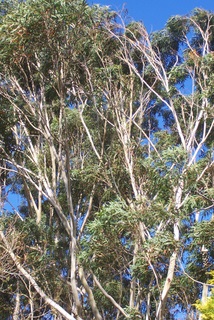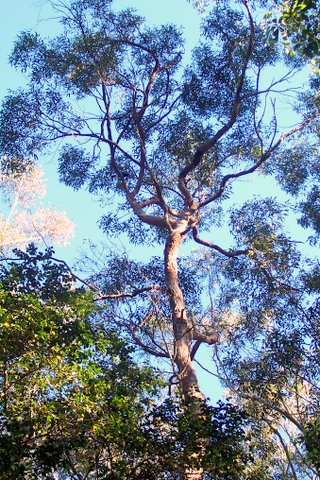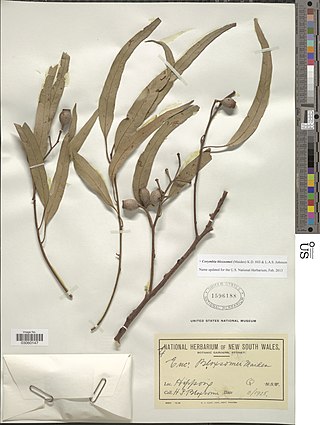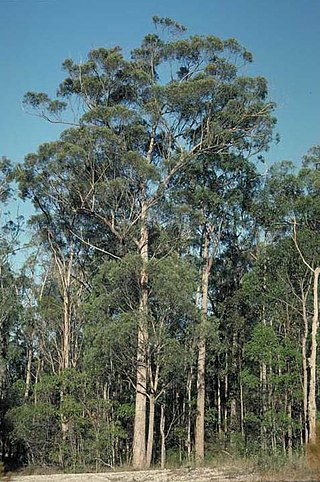
Eucalyptus moluccana, commonly known as the grey box, gum-topped box or terriyergro, is a medium-sized to tall tree with rough bark on part or all of the trunk, smooth bark above, lance-shaped adult leaves, flower buds usually in groups of seven, white flowers and cup-shaped to barrel-shaped fruit. It is found in near-coastal areas of Queensland and New South Wales.

Eucalyptus pilularis, commonly known as blackbutt, is a species of medium-sized to tall tree that is endemic to eastern Australia. It has rough, finely fibrous greyish bark on the lower half of the trunk, smooth white, grey or cream-coloured bark above, lance-shaped to curved adult leaves, flower buds in groups of between seven and fifteen, white flowers and hemispherical or shortened spherical fruit.

Eucalyptus notabilis, commonly known as Blue Mountains mahogany or mountain mahogany, is a species of small to medium-sized tree endemic to eastern Australia. It has rough, fibrous bark on the trunk and branches, lance-shaped to curved adult leaves, flower buds in groups of between seven and eleven, white flowers and hemispherical or conical fruit.

Eucalyptus acmenoides, commonly known as white mahogany or barayly, is a tree that is endemic to eastern Australia. It is a large tree with grey to reddish brown, stringy bark, lance-shaped leaves, oval to spindle-shaped buds and more or less hemispherical fruits. The two sides of adult leaves are very different shades of green.

Eucalyptus resinifera, commonly known as red mahogany or red messmate, is a species of medium-sized to tall tree endemic to coastal areas of eastern Australia. It has rough, stringy or fibrous bark on the trunk and branches, lance-shaped adult leaves, flower buds in groups of between seven and eleven, white flowers and hemispherical, conical or cup-shaped fruit.

Eucalyptus umbra, known as the broad-leaved white mahogany, is a species of small to medium-sized tree that is endemic to northern New South Wales. It has rough, fibrous to stringy bark on the trunk and branches, lance-shaped to curved adult leaves, flower buds in groups of seven to fifteen, white flowers and cup-shaped to hemispherical fruit.

Eucalyptus scias, known as the large-fruited red mahogany, is a species of small, straggly to medium-sized tree that is endemic to the high rainfall coastal areas of New South Wales. It has rough, fibrous bark on the trunk and branches, lance-shaped adult leaves, flower buds in groups of three or seven, white flowers and cup-shaped, conical or bell-shaped fruit.

Eucalyptus pellita, commonly known as the large-fruited red mahogany, is a species of medium to tall tree that is endemic to north-eastern Queensland. It has rough, fibrous or flaky bark on the trunk and branches, lance-shaped to egg-shaped adult leaves, flower buds in groups of seven, white flowers and cup-shaped to conical fruit.

Eucalyptus tenella, commonly known as narrow-leaved stringybark, is a species of small to medium-sized tree that is endemic to New South Wales. It has stringy bark, narrow lance-shaped to linear leaves, flower buds in group of seven to fifteen, white flowers and hemispherical fruit.

Eucalyptus apothalassica is a tree native to New South Wales in eastern Australia. Common names for the species include inland white mahogany.
Eucalyptus hypostomatica, commonly known as Pokolbin box, is a species of erect, medium-sized to tall tree that is endemic to New South Wales. It has rough, flaky bark on the trunk and larger branches, lance-shaped adult leaves, flower buds in groups of seven, white flowers and barrel-shaped or conical fruit.

Eucalyptus psammitica, commonly known as bastard white mahogany, is a species of small to medium-sized tree that is endemic to eastern Australia. It has rough, stringy or fibrous, prickly bark on the trunk and branches, lance-shaped to curved adult leaves, flower buds in groups of between seven and eleven, white flowers and cup-shaped to hemispherical fruit.

Corymbia bloxsomei, commonly known as yellowjack, yellow jacket or yellow bloodwood, is a species of tree that is endemic to inland, south-eastern Queensland. It has thick, rough scaly bark on the trunk and larger branches, lance-shaped or curved adult leaves, flower buds in groups of seven, nine or eleven, creamy white to pale yellow flowers and barrel-shaped, urn-shaped or spherical fruit.

Eucalyptus carnea, known as the thick-leaved mahogany or broad-leaved white mahogany, is a species of tree that is endemic to coastal areas of eastern Australia. It has rough, stringy bark from the trunk to the thinnest branches, lance-shaped or curved adult leaves, flower buds in groups of between seven and eleven, white flowers and cup-shaped to hemispherical fruit.

Eucalyptus tenuipes, known as the narrow-leaved white mahogany, is a species of small tree that is endemic to Queensland. It has rough, fibrous bark, narrow lance-shaped leaves arranged in opposite pairs, flower buds in group of eleven to twenty, white flowers and spherical to hemispherical fruit.

Corymbia leichhardtii, commonly known as rustyjacket, Leichhardt's rustyjacket, or yellow jacket, is a species of tree that is endemic to Queensland. It has rough, tessellated bark on the trunk and branches, lance-shaped or curved adult leaves, flower buds in groups of seven, white flowers and barrel-shaped, urn-shaped or shortened spherical fruit.
Eucalyptus delicata is a species of tree that is endemic to Western Australia. It has rough, fibrous to scaly bark on the trunk, smooth white to greyish bark above, linear to narrow lance-shaped adult leaves, flower buds in groups of between seven and eleven, creamy white flowers and more or less spherical to barrel-shaped fruit.
Eucalyptus latisinensis, commonly known as white mahogany, is a species of tree that is endemic to Queensland. It has rough, fibrous to stringy bark, lance-shaped to curved adult leaves, flower buds in groups of seven to eleven or more, white flowers and shortened spherical to hemispherical fruit.

Eucalyptus mediocris, commonly known as inland white mahogany, is a eucalypt that is endemic to the Australian state of Queensland.

Eucalyptus socialis subsp. eucentrica, commonly known as the inland red mallee, is a subspecies of mallee that is endemic to inland Australia. It usually has rough bark on the base of the trunk, smooth bark above, lance-shaped adult leaves, flower buds in groups of between seven and eleven, pale creamy yellow flowers and barrel-shaped to urn-shaped or spherical fruit.




















